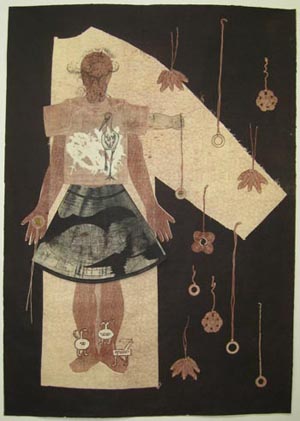Art exhibition to celebrate publication at UCSC's Cowell gallery Sept. 27-Oct. 11
By Scott Rappaport.
By the early 1900’s, over 40 percent of the world’s Jews lived within the borders of the Russian empire.
For more than a century, this large Jewish population was restricted to a region called the Pale of Settlement, where they forged their own distinctive way of life—creating a culture that was so isolated from the world, historians began to call the area “The Jewish Dark Continent.”
But just two years before the start of World War I, a socialist revolutionary named An-sky began an ambitious expedition to preserve and document the region’s Jewish traditions and culture.
He began collecting jokes, stories, healing techniques, incantations, songs, and photographs.
An-sky also created a massive ethnographic survey questionnaire made up of 2,087 questions in Yiddish about Jewish customs, activities and beliefs.
Although there are no recorded answers to any of the questions—the onset of the first World War effectively ended the project—the survey questions themselves have now become an invaluable resource in illuminating everyday Jewish life in Eastern Europe.
This October, UC Santa Cruz professorof literature and history Nathaniel Deutsch will offer the first complete translation of that little known questionnaire, as well as the story of An-sky’s exhaustive attempt to document a culture during an extraordinarily volatile time in world history.
Deutsch’s book The Jewish Dark Continent: Life and Death in the Russian Pale Settlement, will be published in late October by Harvard University Press.
For Deutsch—co-director of the Jewish Studies Program at UC Santa Cruz—completing the book was a laborious undertaking that took nearly eight years to complete.
“I felt like it almost killed me, but it was well worth it,” said Deutsch. “It involved grueling scholarship and research—my whole house was covered for years with all kinds of books in many different languages.”
Deutsch noted that the majority of Jews now living in the United States are descendants from Russia’s Pale of Settlement region.
He added that the questions in the survey reflect intimate knowledge of Jewish culture—exploring the breadth of its traditions and beliefs—from daily activities to spiritual practices and marital intimacies.
“Many of the accounts and histories of this type tend to focus on political movements—the big events of history, “ said Deutsch. “This document provides a look at everyday life with regular people. And it reveals what life was like not only for men, but also for women.”
“It’s one of the earliest documents to pay attention to the lives of Jewish women in this part of the world,” he added.
After describing his project in a publication of the National Yiddish Book Center, Deutsch was contacted by artist Debra Olin, an award-winning printmaker living in Massachusetts.
Inspired by a deep interest in Jewish women’s folk traditions, Olin had questions about Jewish customs and beliefs connected to pregnancy and childbirth in the Pale of Settlement.
Collaborating with Deutsch, she began incorporating questions from the survey into her artwork.
The result is an exhibition titled Every Protection: Exploring Pregnancy and Childbirth in the Jewish Pale of Settlement, running from September 27 to October 11 at the Eloise Pickard Smith Gallery of Cowell College at UC Santa Cruz.
Although they have been corresponding since 2008, Olin and Deutsch will meet in person for the first time due to the UCSC exhibition; they will both speak at the opening reception on Tuesday, Sept. 27, at 4 p.m.
“An-sky was interested in preserving the Jewish folk traditions to use them as seeds to form into a modern, vibrant Jewish culture—spawning new songs, theatrical productions, museums…” Deutsch noted.
“So to me, it’s particularly compelling that something so simple, that seems so inartistic—an ethnographic questionnaire—can inspire and literally become the raw material for contemporary Jewish art.”


